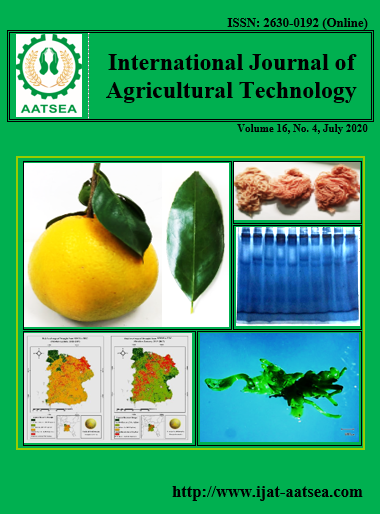Phenols and peroxidase activity in Pepper yellow leaf curl Thailand virus (PepYLCThV) resistant and susceptible chili (Capsicum annuum L.) genotypes
Main Article Content
Abstract
Chilli (Capsicum annuum L.) is most commonly cultivated species. Pepper yellow leaf curl virus (PepYLCV) causes serious leaf curl disease of chili. In order to understand plant defence mechanism to PepYLCV disease, the study reported a response of total phenols and peroxidase activity in two contrasting pepper genotypes (resistant and susceptible) against PepYLCThV. The total phenolic content of uninoculated plants in susceptible genotype (KKU-P31118) showed higher value than resistance genotype (9853-123) at both stages. However, the amount of total phenolic content in resistant genotypes was increased in juvenile and mature leaves in response to inoculation with PepYLCThV. In case of susceptible one, it was decreased as compared to uninoculated control. On the other hand, the peroxidase activity in chilli genotypes and at different stage of leaves was increased every week after inoculation and increased as a comparison to uninoculated plants. Hence, our finding suggested that the total phenols may act as defence mechanism in resistant genotype 9853-123.
Article Details

This work is licensed under a Creative Commons Attribution-NonCommercial-NoDerivatives 4.0 International License.
References
Anand, T., Bhaskaran, R., Raguchader, T., Samiyappan, R., Prakasam, V. and Gopalakrishnan, C. (2009). Defence responses of chlli fruits to Colletotrichum capsici and Alternaria alternate. Biologia Plantarum, 53:553-559.
Bhavani, S. A. V. and Jindal, P. C. (2001). Biochemical resistance of grape genotypes against anthracnose. Indian Journal of Agricultural Sciences, 35:44-47.
Bharathi, R., Vivekenanthan, R., Harish, S., Ramanathan, A. and Samiyappan, R. (2004). Rhizobacteria-based bio-formulations for the management of fruit rot infection in chillies. Crop Protection, 23:835-843.
Bruce, R. J. and West, C. A. (1989). Elicitation of lignin biosynthesis and isoperoxidase activity by pectic fragment in suspension cultures of castor bean. Journal of Plant Physiology, 91:889-897.
Coley, P. (1980). Effect of leaf age and plant life history patterns on herbivory. Nature, 284:545-546.
Cliff, S., Fawer, M.S., Maier, G., Takata, K. and Ritter, G. (1994). Enzyme assays for the phenolic content of natural juices. Journal of Agricultural and Food Chemistry, 42:1824 1828.
Chiemsombat, P., Srikamphung, B., Yule, S. and Srinivasan, R. (2018). Begomoviruses associated to Pepper yellow leaf curl disease in Thailnd. Journal of Agricultural Research, 3:000183.
Dwi, W. G., Sri, H. H. and Muhamad, S. (2017). Susceptible Phase of chili pepper due to Yellow Leaf Curl Begomovirus infection. International Journal on Advanced Science, Engineering and Information Technology, 7:594-601.
Graham, M. Y. and Graham, T. L. (1991). Rapid accumulation of anionic peroxidases and phenolic polymers in soybean cotyledon tissues following treatment with Phytophthora megaspermaf. sp. glycinea wall glucan. Journal of Plant Physiology, 97:1445-1455.
Goncalves, L. S. A., Rodrigues, R., Diz, M. S. S. and Robaina, R. R. (2013). Peroxidase is involved in Pepper yellow mosaic virus resistance in Capsicum baccatum var. pendulum. Genetics and Molecular Research, 12:1411-1420.
Hidayat, S. H., Rusli, E. S. and Aidawati, N. (1999). The use of universal primer and PCR to detect Gemini virus on chilli pepper. In proceeding national congress and scientific seminar Indonesian phytopayology association. Purwokerto, pp. 355-359.
Jennings, P. H., Braunaman, B. L. and Zscheille, F. P. (1969). Peroxidase and polyphenol oxidase acyivity associated with Helminthosporium lef spot of maize. Phytophatology, 59:963-967.
Jabeen, N., Ahmed, N., Ghani, M. Y. and Sofi, P. A. (2009). Role of phenolic compounds in resistance to chilli wilt. Communications in Biometry and Crop Science, 4:52-61.
Kumar, S., Kumar, S., Singh, M., Singh, A. K. and Rai, M. (2006). Identification of host plant resistant to pepper leaf curl virus in chilli (Capsicum species). Scientia Horticulturae, 110:359-361.
Lattanzio, V., Lattanzio, M. T. and Cardinali, A. (2006). Role of phenolics in the resistance mechanisms of plants against fungal pathogens and insects. In Imperato, F. (Ed.), Phytochemistry: Advances in Research, Research Signpost, Trivandrum, Kerala, India, pp. 23-67.
Malik, C. P. and Singh, M. B. (1980). In plant enzymology and Histoenzymology. Kalyani publishers, New Delhi, pp. 53.
Nicholson, R. L. and Hammerschmidt, R. (1992). Phenolic compound and their role in disease resistance. Annual Review of Phytopathology, 30:369-382.
Privalle, L., Estruch, J., Wright, M., Hill, M. B., Dowd, P.F. and Bellows, T. S. (1999). Methods for Conferring Insect Resistance to a Monocot Using a eroxidase Coding Sequence. Patent 6002068. Assignee, Novartiss Finance Corporation, Ohio State University.
Passardi, F., Penel, C. and Dunand, C. (2004). Performing the paradoxical: how plant peroxidases modify the cell wall. Trends in Plant Science, 9:534-540.
Rai, V. P., Jaiswal, N., Kumar, S., Singh S. P., Kumar, R. and Rai, A. B. (2010). Response of total phenols and peroxidase activity in chilli exposed to pepper leaf curl virus disease. International Journal of Vegetable Science, 37:78-80.
Thompson, R. H. (1964). Structure and reactivity of phenolic compounds. In: Harborne EB ed. Biochemistry of Phenolic Compounds, Academic press, NewYork. pp. 1-32.
Van Loon, L. C., Bakker, P. A. H. M. and Pieterse, C. M. J. (1998). Systemic resistance induced by rhizosphere bacteria.Annual Review of Phytopathology, 36:453-483.


